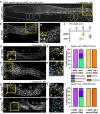An RNAi screen of Rab GTPase genes in Caenorhabditis elegans reveals that morphogenesis has a higher demand than stem cell niche maintenance for rab-1 in the somatic cells of the reproductive system
- PMID: 40239019
- PMCID: PMC12135009
- DOI: 10.1093/g3journal/jkaf085
An RNAi screen of Rab GTPase genes in Caenorhabditis elegans reveals that morphogenesis has a higher demand than stem cell niche maintenance for rab-1 in the somatic cells of the reproductive system
Abstract
Membrane trafficking is a crucial function of all cells and is regulated at multiple levels from vesicle formation, packaging, and localization to fusion, exocytosis, and endocytosis. Rab GTPase proteins are core regulators of eukaryotic membrane trafficking, but developmental roles of specific Rab GTPases are less well characterized, potentially because of their essentiality for basic cellular function. Caenorhabditis elegans gonad development entails the coordination of cell growth, proliferation, and migration-processes in which membrane trafficking is known to be required. Here, we take an organ-focused approach to Rab GTPase function in vivo to assess the roles of Rab genes in reproductive system development. We performed a whole-body RNAi screen of the entire Rab family in C. elegans to uncover Rabs essential for gonad development. Notable gonad defects resulted from RNAi knockdown of rab-1, the key regulator of ER-Golgi trafficking. We then examined the effects of tissue-specific RNAi knockdown of rab-1 in somatic reproductive system and germline cells. We interrogated the dual functions of the distal tip cell as both a leader cell of gonad organogenesis and the germline stem cell niche. We find that rab-1 functions cell-autonomously and non-cell-autonomously to regulate both somatic gonad and germline development. Gonad migration, elongation, and gamete differentiation-but surprisingly not germline stem niche function-are highly sensitive to rab-1 RNAi.
Keywords: C. elegans; Animalia; RNAi; Rab GTPase; gamete differentiation; germline; gonad; stem cell.
© The Author(s) 2025. Published by Oxford University Press on behalf of The Genetics Society of America.
Conflict of interest statement
Conflicts of interest: The authors declare no conflicts of interest.
Figures





Update of
-
An RNAi screen of Rab GTPase genes in C. elegans reveals that somatic cells of the reproductive system depend on rab-1 for morphogenesis but not stem cell niche maintenance.bioRxiv [Preprint]. 2024 Dec 6:2024.12.03.626641. doi: 10.1101/2024.12.03.626641. bioRxiv. 2024. Update in: G3 (Bethesda). 2025 Jun 4;15(6):jkaf085. doi: 10.1093/g3journal/jkaf085. PMID: 39677816 Free PMC article. Updated. Preprint.
Similar articles
-
An RNAi screen of Rab GTPase genes in C. elegans reveals that somatic cells of the reproductive system depend on rab-1 for morphogenesis but not stem cell niche maintenance.bioRxiv [Preprint]. 2024 Dec 6:2024.12.03.626641. doi: 10.1101/2024.12.03.626641. bioRxiv. 2024. Update in: G3 (Bethesda). 2025 Jun 4;15(6):jkaf085. doi: 10.1093/g3journal/jkaf085. PMID: 39677816 Free PMC article. Updated. Preprint.
-
The Rac pathway prevents cell fragmentation in a nonprotrusively migrating leader cell during C. elegans gonad organogenesis.Curr Biol. 2024 Jun 3;34(11):2387-2402.e5. doi: 10.1016/j.cub.2024.04.073. Epub 2024 May 21. Curr Biol. 2024. PMID: 38776905 Free PMC article.
-
The jaw of the worm: GTPase-activating protein EAT-17 regulates grinder formation in Caenorhabditis elegans.Genetics. 2013 Sep;195(1):115-25. doi: 10.1534/genetics.113.152538. Epub 2013 Jun 21. Genetics. 2013. PMID: 23792950 Free PMC article.
-
Gonad morphogenesis and distal tip cell migration in the Caenorhabditis elegans hermaphrodite.Wiley Interdiscip Rev Dev Biol. 2012 Jul-Aug;1(4):519-31. doi: 10.1002/wdev.45. Wiley Interdiscip Rev Dev Biol. 2012. PMID: 23559979 Free PMC article. Review.
-
Small GTPases.WormBook. 2006 Jan 17:1-18. doi: 10.1895/wormbook.1.67.1. WormBook. 2006. PMID: 18050472 Free PMC article. Review.
References
MeSH terms
Substances
Grants and funding
LinkOut - more resources
Full Text Sources
